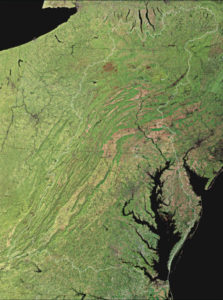
The Chesapeake Bay (bottom right) absorbs pollution from 64,000 square miles of the American northeast, a watershed stretching from New York to Virginia with 18 million people.
Credit: USGS
LANCASTER, PENNSYLVANIA — Linn Moedinger’s farm has been in his family for 10 generations, dating back to 1711, 150 acres of rich fields and meandering streams nestled in the heart of Pennsylvania Dutch country. As long as the family has owned it, it’s been a working farm; today Moedinger leases the fields to a neighbor who grows corn, wheat and soybeans. The family relies on the crop income to keep up the historic farmhouses they call home.
Nonetheless, Moedinger recently surrendered 12 acres of property along his tiny, unnamed streams to plant wide strips of oak trees, dogwood shrubs and other native plants, paid for by the government. If all goes according to plan, that land will never produce crops again.
The […]










